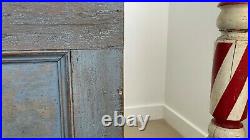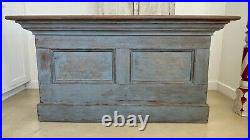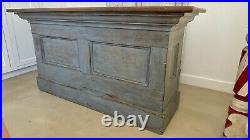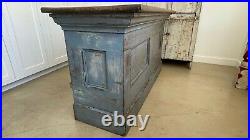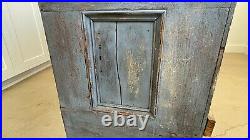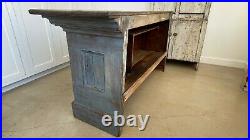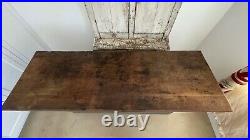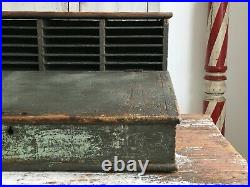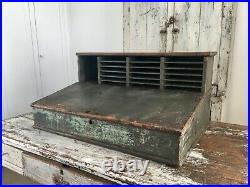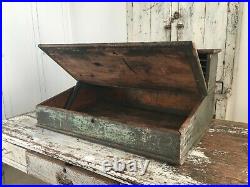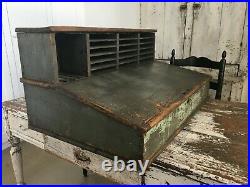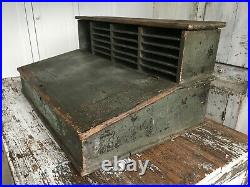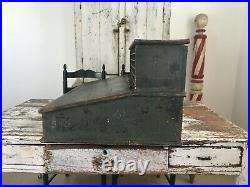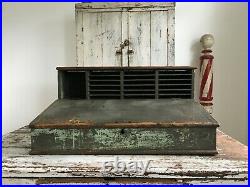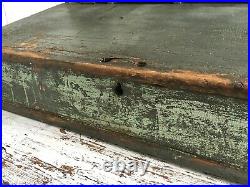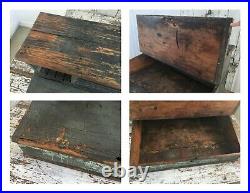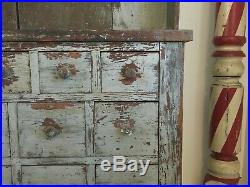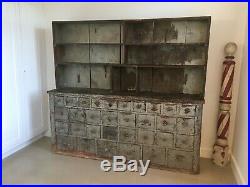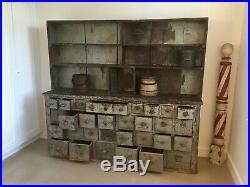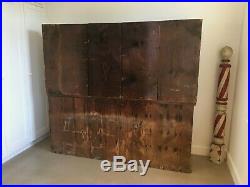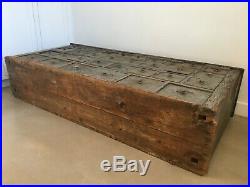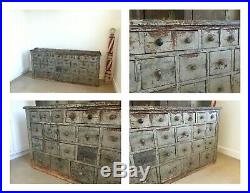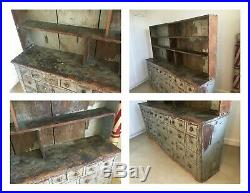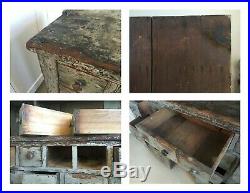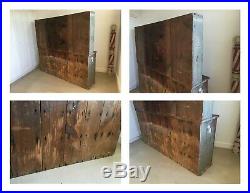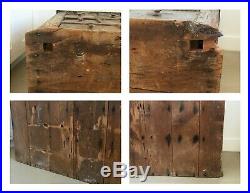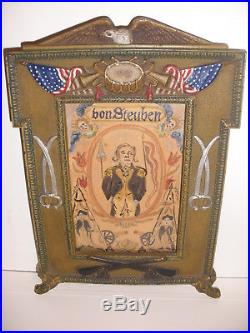
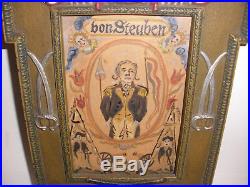
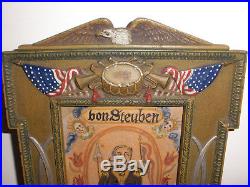
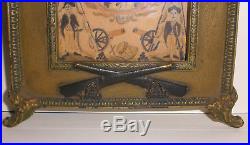
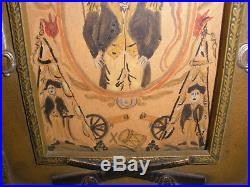
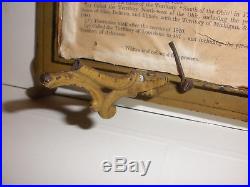
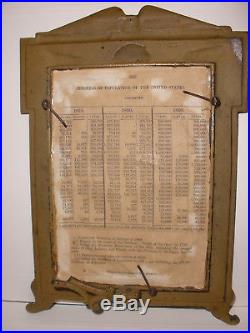

ESTATE FROM PRIVATE COLLECTION. FRAME MEASURES APPROXIMATE 9″x 6.5″. SOME WEAR FROM USE AND AGE. PLEASE SEE THE PICTURES FOR CONDITION AND JUDGE FOR YOURSELF. Major General Friedrich Wilhelm Augustus, Baron von Steuben. Frederick William Ludolf Gerhard Augustin von Steuben was born on September 17, 1730 in the fortress town of Magdeburg in Prussia. Following in his father’s footsteps, Steuben joined the Prussian Army in 1747, when he was 17 years old. In May 1756, the Seven Years War began in Europe, and Prussia and Britain were pitted against France, Austria, and Russia. At this time, Steuben was a second lieutenant. He was wounded at the Battle of Prague, where the Prussian army was victorious, despite being outnumbered 2 to 1. In 1758, he served as Gen. Johann von Mayer’s adjutant and principle staff officer in a special detached corps. Steuben was promoted to first lieutenant in 1759, and he was wounded at the Battle of Kunersdorf during the summer of that year. On June 26, 1761, he was transferred to general headquarters, where he served as a staff officer in the position of a deputy quartermaster. Later in 1761, he was taken prisoner when Maj Gen. Von Knoblock surrendered at Treptow on the Russian front. In 1762, he was released, promoted to captain, and he eventually became an aide-de-camp to Frederick the Great. Then he joined the King’s personal class on the art of war, where young officers were trained in the complicated art of leadership. Shortly, following the peace treaty, he was discharged from the Prussian army on April 29, 1763. By 1763, Steuben had gained all of his military experience which would be so valuable in his service to the American cause. He had learned the methods of war in, what many considered to be, the greatest and most advanced army in the world at the time. Also, Steuben received training with a special detached corps and as a general staff officer when the two concepts were virtually unknown to the rest of the world. This prepared Steuben for his work with the American army, where it became his task to bring uniformity and order to the drills and maneuvers of the Continental Army. The road to America began in 1763, when Steuben met Louis de St. Germain later became the French Minister of War during the American Revolution. This casual acquaintance was renewed in France while Steuben was serving as Grand Marshall to the Prince of Hollenzollern-Hechingen. As Grand Marshall, Steuben served as the administrative director for the Prince and his court. During this period, he received the Star of the Order of Fidelity on May 26, 1769, from the Duchess of Wurttemburg, a niece of Frederick the Great, whom Steuben had greatly impressed. In 1771, he received the title of Baron, from the Prince of Hollenzollern-Hechingen. From 1775 onward, Baron von Steuben began looking for work in some kind of military capacity. He inquired about serving in the British, French, and Austrian armies, but no positions materialized. In 1777, he traveled to France, where he heard talk of glories and riches to be won in a revolution across the Atlantic Ocean. Germain, Steuben was introduced to the American ambassadors to France, Silas Deane and Benjamin Franklin. However, the two ambassadors were unable to promise Steuben a rank or pay in the American army. The Continental Congress had grown tired of foreign mercenaries coming to America and demanding a high rank and pay, based on promises made to them by the American ambassadors. These men would be promoted in rank over deserving American officers, causing discontent in the army. As a result, Congress ordered the ambassadors to stop this practice. Steuben would have to go to America strictly as a volunteer, and present himself to Congress. Upon his return to Prussia, Steuben was unable to find suitable employment. His passage to America was paid by the French government. On September 26, 1777, Baron von Steuben, his Italian greyhound, Azor, Louis de Pontiere, his aide de camp, and Pierre Ettionne Duponceau, his military secretary, embarked for America to serve in the revolution. They arrived in Portsmouth on December 1, 1777, where they were almost arrested for being British because the Baron had mistakenly outfitted them in red uniforms. Steuben and his party then traveled overland, through Boston to York, Pennsylvania, arriving there on February 5, 1778. When the Baron met with Congress, he presented them with a letter of introduction from Benjamin Franklin. The letter introduced him as His Excellency, Lieutenant General von Steuben, Apostle of Frederick the Great. Actually, Steuben had only been a captain. Through the translation of Steuben’s position in the Prussian army, he was made a higher ranking officer in the American army’s translation. Steuben’s title while in the Prussian army as a staff officer was Deputy to the Quartermaster General. In French, it was “Lieutenant General Quarters Maitre, ” so Franklin wrote “Lieutenant General” in his letter of introduction, which gave the impression that Steuben held this specific rank in the Prussian army. Arrangements were made for Steuben to be paid following the successful completion of the war according to his contributions. Congress told the Baron to report to General Washington at Valley Forge. He arrived at the camp on February 23, 1778. One soldier’s first impression of the Baron was of the ancient fabled God of War he seemed to me a perfect personification of Mars. The trappings of his horse, the enormous holsters of his pistols, his large size, and his strikingly martial aspect, all seemed to favor the idea. Steuben made a favorable enough impression upon Washington to be appointed temporary Inspector General. He went out into the camp to talk with the officers and men, inspect their huts, and scrutinize their equipment. What he found was an army short of everything, except spirit. He was quoted as saying no European army could have held together in such circumstances. Steuben set to work. His first step was to write the drills for the army. At this time, each state used different drills and maneuvers, patterned upon various European methods. As Inspector General, Steuben’s task was to create one standard method, thus coordinating the entire Continental Army. As he could not speak or write English, Steuben originally wrote the drills in French, the military language of Europe at the time. His secretary, Duponceau, translated the drills from French into English. Then John Laurens and Alexander Hamilton, two of Washington’s aide-de-camps, rewrote them into military language. They were then given to the brigade inspectors, who made copies of the next lesson in the orderly book for each respective brigade and regiment. Copies were taken from the orderly book to each company and then to each officer. The Baron used the Commander-in-Chief’s Guard and men from each state, about 120 men total, as a model company to demonstrate each new lesson. Steuben would write the new drills at night, staying only several days ahead of the whole army. He tried to fit his drills to the men he was teaching in the quickest possible time, by making them as simple as possible. In this way, uniform maneuvers and discipline was given to the army in a very rapid and orderly fashion. Up to this time, the American officers had accepted the British practice of letting the sergeants drill the men, as it was thought to be ungentlemanly for officers to do so. Steuben set a precedent by working with the troops directly. The American officers felt threatened by this practice, as well as by the seemingly unlimited powers of Steuben’s office. Consequently, on June 15, 1778, Washington issued orders to govern the Inspector General’s office until Congress took further steps. The Baron’s willingness and ability to work with the men, as well as his use of profanity (in several different languages), made him popular among the soldiers. On May 6, 1778, the Continental Army showed off its newly acquired skills when they celebrated the news of the French Alliance. Many of the soldiers, officers, and civilians noticed the marked improvement and increased professionalism demonstrated by the American troops. The same day, Steuben was handed his commission from the Continental Congress, as Inspector General, with the rank of Major General. Shortly after the army left Valley Forge, they fought a battle at Monmouth Courthouse, in New Jersey. The battle was essentially a draw, but the Continental Army fought the British to a standstill. Von Steuben went to Philadelphia to write his book of regulations. Francois de Fleury, a French volunteer serving in the Continental Army, assisted in writing the original French text. Benjamin Walker translated it into English. It was illustrated by Capt. Pierre Charles L’Enfant, the man who would design Washington D. The “Regulation for the Order and Discipline of the Troops of the United States” was approved by Congress in March 1779. It became known as the “Blue Book, ” and it was used by the United States Army until 1814. Von Steuben rejoined the Continental Army on April 27, 1779, and he served throughout the remainder of the war. He was instructor and supply officer for Gen. Nathanael Greene’s southern army, which fought the key battles that led to the British surrender at Yorktown in 1781. Steuben commanded of one of the three divisions in the Continental Army at Yorktown. In 1783, he helped demobilize the army, and resigned in 1784. After the war, he continued petitioning for compensation for his services. Congress did pay a portion of the amount Steuben expected, but not all. Consequently, he was forced to retire from New York City to his land holdings in order to live out the remainder of his life. Steuben never married, and he died on his 16,000 acre farm tract in the Mohawk Valley of New York, on November 28, 1794. Although he never received the financial rewards he expected, Steuben will never be forgotten in the annals of American history. His administrative brilliance in organizing, training, and preparing the Continental Army for battle will ensure his legacy in the cause of American independence. PAYMENTS EXPECT IN 4 DAYS. THANKS AND GOOD LUCK. The item “Antique American cast iron patriotic frame General von Steuben folk art painting” is in sale since Monday, September 25, 2017. This item is in the category “Antiques\Decorative Arts\Picture Frames”. The seller is “mdeur29″ and is located in Scotch Plains, New Jersey. This item can be shipped to United States.
- Original/Reproduction: Original
- Age: 1800-1849

